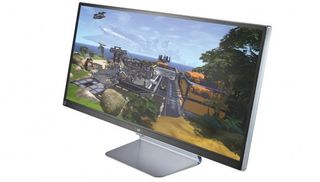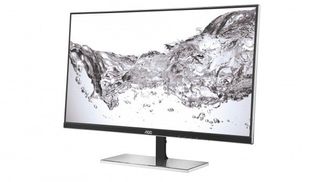LG's 34-inch 21:9 monitor has convinced me that ultrawide is better than 4K

Having spent a long time using 4K monitors I've become a bit jaded about next-gen gaming resolutions. They don't tangibly deliver anything above what you can get from a beautiful 27-inch IPS 1440p screen. The problem is, while 4K does deliver a huge upgrade in terms of pixel count, it doesn't make a huge difference in games where the texture resolution hasn't changed. All you're really doing is shanking your frame rate in return for the possibility of being able to knock your anti-aliasing settings down a notch. If you want a dramatic upgrade of your gaming monitor you should have a good think about the new ultrawide 34-inch 21:9 screens trickling out of all good monitor manufacturers' factories at the moment.
4K enthusiasts might talk up the benefits of increased desktop real estate, and that would be a valid stance if it weren't for the fact the affordable 4K screens are all 28-inch and at 100% scaling it's real hard to read anything without your nose touching the panel. Advances in desktop and browser scaling mean you can increase the size of fonts, icons and web pages, but then you've got to say bye-bye to that extra space.
The extra width of a 21:9 screen provides an extra dimension to your games that 4K simply can't. The impact is dramatic, and something that really does need to be experienced to get the full effect.

I've had 4K panels on my desk in the office and that barely raised a flicker of interest, but as soon as I fired up the LG 34UM95, a crowd swarmed the testing desk—not seen since we last had the Oculus Rift out. Mac Format and Imagine FX watched enraptured as we blazed through asteroid fields in Elite: Dangerous, swapped hot lead with internet people in Battlefield 4 and sat slack-jawed at the superwide HD trailer for Chris Nolan's Interstellar.
You may not spend much time, if any, looking at the far edges of the ultrawide display, but the extra visual cues you get from the extra peripheral vision makes a huge difference in-game. We have seen 21:9 panels before, but the 29-inch 2560x1080 screens just felt too cramped in the vertical space to use on a Windows desktop. This 3440x1440 resolution however looks fantastic even when you're not in-game.

Another bonus: you're not crushing your poor GPU shifting up to this ultrawide res. There's just under 40% more pixels in this 21:9 panel than there is in a standard 2560x1440 screen. With 4K resolutions you're looking at more than a 120% increase in pixels for your graphics card to have to cope with.
The only problem right now is price. At around £800 / $1300 this LG 34UM95 is simply too expensive to be a realistic option, but there will be other companies releasing cheaper versions which will essentially have the same screen. AOC and Philips are bringing out similar spec panels for the same price as their affordable 4K screens—those are going to be the real tempters in this new range of gaming display.
The biggest gaming news, reviews and hardware deals
Keep up to date with the most important stories and the best deals, as picked by the PC Gamer team.

Dave has been gaming since the days of Zaxxon and Lady Bug on the Colecovision, and code books for the Commodore Vic 20 (Death Race 2000!). He built his first gaming PC at the tender age of 16, and finally finished bug-fixing the Cyrix-based system around a year later. When he dropped it out of the window. He first started writing for Official PlayStation Magazine and Xbox World many decades ago, then moved onto PC Format full-time, then PC Gamer, TechRadar, and T3 among others. Now he's back, writing about the nightmarish graphics card market, CPUs with more cores than sense, gaming laptops hotter than the sun, and SSDs more capacious than a Cybertruck.
Most Popular

